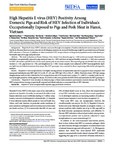High Hepatitis E virus (HEV) Positivity Among Domestic Pigs and Risk of HEV Infection of Individuals Occupationally Exposed to Pigs and Pork Meat in Hanoi, Vietnam
Xuan Hoan, Nghiem
Xuan Huy, Pham
Tien Sy, Bui
Meyer, Christian G.
Van Son, Trinh
Thanh Binh, Mai
Phuong Giang, Dao
Tu Anh, Dam
Bock, Claus-Thomas
Wang, Bo
Van Tong, Hoang
Kremsner, Peter G.
Hu Song, Lee
Linh Toan, Nguyen
Velavan, Thirumalaisamy P.
Background
Hepatitis E virus (HEV) infection can occur through consumption of undercooked pork meat or exposure to animal feces. Because there are scarce data only in developing countries, we assessed whether pigs might be a potential source of human HEV infections in Vietnam. In addition, we determined anti-HEV seroprevalences in the general population and in individuals professionally exposed to pigs and pork meat.
Methods
The study took place in Hanoi, Vietnam. Liver tissues from domestic pigs (n = 210) and serum samples obtained from individuals occupationally exposed to pigs and pork meat (n = 283) and from unexposed healthy controls (n = 168) were screened for HEV-ribonucleic acid (RNA) by reverse-transcription polymerase chain reaction. The exposed group was divided into pork meat vendors (n = 81), pig farmers (n = 96), and slaughterers (n = 106). Serum samples were subjected to HEV immunoglobulin (Ig)G and IgM enzyme-linked immunosorbent assays. The HEV genotypes were assessed by direct sequencing, followed by phylogenetic analyses.
Results
Hepatitis E virus seroprevalence was higher among persons occupationally exposed to pigs/pork meat compared with unexposed individuals (anti-HEV IgM 11% vs 6%, P = .07; anti-HEV IgG 53% vs 31%, P < .0001). Positivity of anti-HEV IgG among slaughterhouse staff was 66%, followed by 51% in pig-farmers and 38% in pork meat vendors (P = .00073). A similar trend was observed for IgM positivity. Of the pig liver tissues, 26 of 210 (12.4%) were positive for HEV-RNA and assessed to be HEV genotype 3.
Conclusions
Hepatitis E virus circulates in domestic pigs in Hanoi and constitutes a permanent zoonotic disease risk. The high HEV seroprevalence among occupationally exposed individuals indicates an associated risk of HEV infection.

